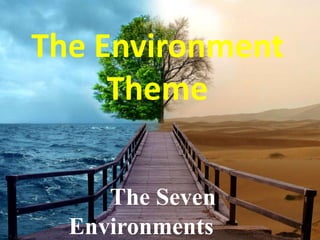
The 7 Natural Environments
- 2. Hello Grade 7’s! I am a new employee at Tripcentral travel agency and I am completely overwhelmed with work! Can you please help me plan a vacation for a difficult client of mine? All she has told me is that she LOVES THE HEAT! I will describe to you the environments of the places that I have in mind for my client. If you help me by the end of class, I can assure that Miss. Bozzelli will have a reward for you next class! THANK YOU!
- 3. Desert Plateau This is a great place for those of you who LOVE the heat. Here a few characteristics of this environment: • No rain, very hot days and cold nights • Very sunny • Flat land, few trees • Poisonous snakes and scorpions • No bugs • No water
- 5. Tundra Lowland-Summer • Summer, some rain, warm days and cool nights • Hilly land, swamps, few short trees • Few caribou • Many bugs • Much safe water
- 7. Grassland Plains • Some rain, very hot days and hot nights • Very sunny • Hilly land, swamps, few short trees • Many large animals like elephants, lions and snakes • Some bugs • No safe water
- 9. Rainforest Lowland • Much rain, hot days and hot nights • Flat land, cannot see far ahead, too many tall trees • Poisonous and other snakes and jaguars • Many bugs • Some safe water
- 11. Mountain Desert • No rain, very hot days and very cold nights • Hilly land, no trees • Poisonous snakes, scorpions and mountain lions in some mountain deserts • No bugs • No water
- 13. Coniferous Forest Lake and Hill Lands • Some rain, hot days and hot nights • Hilly land, swamps, many tall trees • Many large animals like moose, wolves and bears • Many bugs • Much safe water
- 15. Deciduous Forested Mountains- Summer • Summer, some rain, warm days and cool nights • Mountains, many tall trees • Many animals like elk, deer and skunk • Many bugs • Much safe water
Notas del editor
- Atacama Desert- north western coast of Chile. Parts of the desert get rain on occasion, other parts of the Atacama are so dry, they have not received any rain since the mid 1700's. The reason this desert is so dry is because it is bordered on the East by the Andes mountains, the mountains block any clouds from the rain forest on the other side of the mountains from getting over to the desert
- Nunivak Island, Alaska, USA
- Safari, in Kiswahili, simply means "journey". But in English it has become a synonyme for a wildlife viewing adventure in the African bush. 'To go on safari' In Tanzania is, and always will remain a fascinating and exclusive experience! It is well known that Tanzania has beautiful nature reserves rich in wildlife. There are, however, still many false ideas about this big southern neighbour of Kenya. It is true that Tanzania, measured in terms of pro-capita income, is one of the world's poorest countries. It is a fact that the country can feed itself and, what is of greater significance, is that since independence Tanzania politically has been among the most stable African countries. In regard to safety, both for its own citizens and for tourists, it is well ahead of its more economically advanced neighbours.
- Nestled in the interior of Sabah, the Danum Valley Conservation Area is one of the last remaining preserves of primary lowland rainforest in Asia. The Danum Valley provides visitors with an unparalled ecological experience into the wilds and wonders of ancient tropical forests. Within its 438 sq. km. the rich diversity of animal and plant life display the complex interaction of a natural, dynamic ecosystem found only in rainforests. The hot and humid jungle teems with a variety of towering tropical trees, lingering lianas, exotic orchids and overhanging epiphytes. There are few places on earth that can provide such an awe-inspiring spectacle of nature in its original, pristine state.
- The Namib Desert is a desert in Namibia which forms part of the Namib-Naukluft National Park one of Africa's largest. The name "Namib" is of Nama origin. The desert occupies an area of around 50 000 km², stretching some 1,000 miles (1,600 km) along the Atlantic Ocean coast of Namibia, which is named after this desert. Its east-west width varies from 30 to 100 miles (50-160 km). The Namib Desert also reaches into southwest Angola. The Namib Desert is a desert in Namibia which forms part of the Namib-Naukluft National Park one of Africa's largest. The name "Namib" is of Nama origin. The desert occupies an area of around 50 000 km², stretching some 1,000 miles (1,600 km) along the Atlantic Ocean coast of Namibia, which is named after this desert. Its east-west width varies from 30 to 100 miles (50-160 km). The Namib Desert also reaches into southwest Angola.
- Crater Lake National Park, Oregon, United States of America.
- The Monongahela National Forest was established in 1920. Located in the north central highlands of West Virginia, the Monongahela straddles the highest ridges in the State. Elevation ranges from just under 1000' to 4863' above sea level. Variations in terrain and precipitation have created one of the most ecologically diverse National Forests in the country.